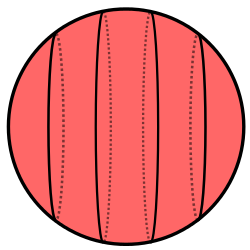Sphere Slices
Beginning with a sphere of radius 1, what is the minimum amount of planar 'slices' through the sphere so that the total surface area of the resultant pieces is greater than 50? Here's one potential method:

The answer is 6.
This section requires Javascript.
You are seeing this because something didn't load right. We suggest you, (a) try
refreshing the page, (b) enabling javascript if it is disabled on your browser and,
finally, (c)
loading the
non-javascript version of this page
. We're sorry about the hassle.
2 solutions
You could also just divide both sides by pi: 50/pi ~ 15.9 --> 4 + 2k > 15.9 --> 2k > 11.9
--> k > 5.95
--> first integer K = 6
Surface area of the ball= 4 π
for every additonal slice of radius r i we add surface area of 2 π r i 2
Total surface area= 4 π + 2 π ∑ i = 1 n r i 2 > 5 0
∑ i = 1 n r i 2 > π 2 5 − 2 ∼ 5 . 9 6
6 very thin plane cuts near center yields a total surface area of about 1 6 π ∼ 5 0 . 2 6 . This knife would help.
Each 'slice' exposes two new faces. In order to maximize the additional area, these faces need to pass through the center point of the sphere. Their combined area will therefore be 2 π . The initial surface area of a sphere with radius 1 is 4 π , so we need to find the smallest integer k where 4 π + k × 2 π > 5 0 . Simple trial and error yields 6 .